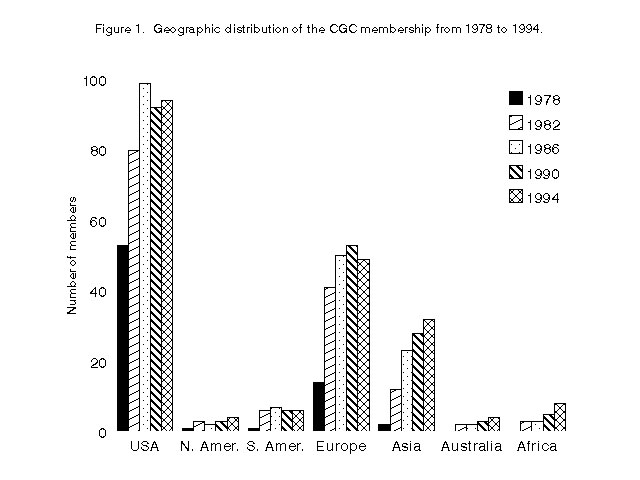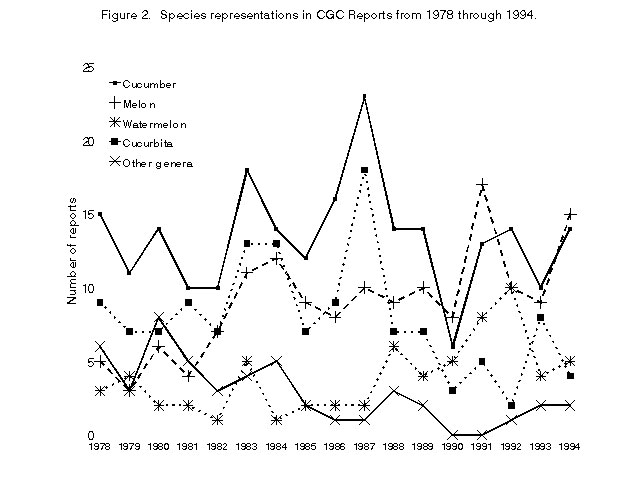The Cucurbit Genetics Cooperative, established in 1977, is similar to many crop genetics cooperatives in that it provides services for researchers interested in the genetics and breeding of a specific plant species, genus or family. These cooperatives serve as an organizational vehicle for scientists to informally communicate the results of their research and development efforts. The cooperative emphasizes the free exchange of information and germplasm among members, both public and private. CGC was founded by Warren Henderson, Richard Lower (North Carolina State University) and Richard Robinson (Cornell University), who were prompted by a number of requests from breeders and researchers, by the success of the Vegetable Improvement Newsletter, and by the attention drawn by a recent article on the genes of the Cucurbitaceae (Robinson et al., 1976). The first CGC meeting was held in conjunction with the ASHS annual meeting in 1977 (where it was erroneously identified as the “Cucumber Genetics Cooperative” in the ASHS Program/Abstract book), and Dick Robinson explained to the 16 people present the background and purpose of CGC and a proposed format for the CGC report. A By-laws Committee and a Gene Nomenclature Committee were subsequently established to formalize the organization of the new Cooperative. To facilitate the handling of articles for the proposed annual CGC report, a five-member Coordinating Committee with a rotating membership was created to oversee each of five major cucurbit species categories: cucumber, melon, watermelon, Cucurbita and “other genera.” Each Coordinating Committee serves a 10-year term, and a new member joins the Coordinating Committee every two years because of the staggered terms. The Chair, on the other hand, does not serve a fixed term. In 1978, the first CGC Report was published. Issued later than anticipated because only a few papers were voluntarily submitted, CGC Report Number 1 nonetheless gave a sense of “completeness” to the creation of the cooperative. That same year the second annual CGC meeting was held in Boston, and although the meeting was requested too late to get in the ASHS Program/Abstract book, it still drew 12 people. It was at this meeting that the CGC By- Laws Committee was created to structure CGC as an organized entity along the lines of the Tomato Genetics Cooperative. However, the By-Laws were not officially adopted until the 1980 CGC meeting. It was always envisioned that CGC would “curate” gene lists and possibly single locus mutants for the major cucurbit crops, and a Gene List Committee was established in 1979 at the Ohio State meeting. The Gene List Committee members have individual responsibilities for the four major cucurbit crop species (cucumber, melon, watermelon and Cucurbita), but all assist in reviewing the gene lists printed annually in the CGC Report and all are involved in overseeing the rules for and revisions of gene nomenclature for the Cucurbitaceae. To assist with the preservation of single locus mutants in the major crop species, Gene Curators were appointed in 1986 for cucumber, melon, Cucurbita, and watermelon. In 1989, multiple curators were appointed for each major crop species to provide redundancy and security to the gene collections, one of which had been partially destroyed due to a fire in a seed storage facility.
Perhaps one of the most useful spin-offs from CGC was the creation of a Crop Advisory Committee (CAC) for cucurbits, which interfaces with USDA efforts to evaluate and catalogue the Plant Introduction (PI) collection, and which helps establish priorities for these endeavors. This effort originated at the 1982 meeting in Ames, Iowa, where a motion was carried to established the CAC. Following little response from the USDA, CGC at the 1983 meeting in McAllen, Texas, voted that the request to form a CAC be resubmitted to USDA. The CAC was finally established in December 1993, and the first meeting was help in September 1984.
The fledgling “Vine Crops CAC” was charged with drafting descriptor lists, setting priorities for germplasm collection and evaluation, and reviewing proposals for cucurbit germplasm exploration, collection, and evaluation. By 1988, the renamed Cucurbit CAC (CCAC) had surveyed the genetic resources in the Cucurbitaceae, identified severe problems with USDA efforts to maintain this germplasm, and suggested improvements in preservation and exploration activities (Robinson, 1994). With the maturation of the advisory capacity for CAC’s of many crops to USDA germplasm efforts, CCAC (now known as the Cucurbit Crop Germplasm Committee) continues to play an active and supportive role in preserving these valuable resources.
Over the years, the CGC membership (and membership dues!) and the make-up of the CGC report have changed. Figure 1 illustrates the geographical distribution of the CGC membership in four year increments from 1978 to 1994. As is evident, the initial CGC membership was predominately in the U.S., with a smaller contingent in Europe (primarily France and the Netherlands) and scattered representation in Asia, South America and North America (excluding the U.S.). Over the next decade and a half, membership increments were seen in every geographical region, with especially dramatic early increases from Europe and later increases from Asia. Currently, more than half of the CGC membership is from countries other than the U.S., a characteristic shared with other genetics cooperatives such as TGC (1994).  Although CGC is a global society, foreign CGC members pose special problems and opportunities. Among the opportunities, foreign members can expect fairly rapid publication of their research articles with no page charges. (Additionally, CGC membership is not a requirement for publication in the annual report.) Foreign members also benefit from international exposure and dissemination of their research efforts. Among the drawbacks for foreign members, however, is the fact that the annual CGC business meetings are usually held in conjunction with the annual ASHS meeting (usually in the U.S.), and it is difficult for international members to attend. Also, foreign members subscribing by surface mail may receive their copy of the annual report up to three months later than their U.S. colleagues. Written communications can be slow, although the increasing use of the Internet by some members has sped up interactions. The use of English as the official language of CGC creates difficulty for some individuals, both in reading the annual report and in submitting research articles for publication. Last, there is the difficulty of exchanging foreign currency, since CGC requires membership dues be paid in U.S. dollars drawn on a U.S. bank. In some countries, the cost of converting currency and issuing a check can be as costly or even more expensive than the membership itself. The CGC Annual Report has also grown in size over the years, with the 1994 report being the largest ever at 180 pages. Figure 2 illustrates the number of research articles submitted in the various commodity/species categories over the years. Typically, the number of submissions in the Cucumis categories (cucumber and melon), perhaps reflective of the larger economic value represented by these crops. However, as CGC’s membership has grown, particularly in the international arena, there have been increasing numbers of submissions in other categories including the “other genera” section.
Although CGC is a global society, foreign CGC members pose special problems and opportunities. Among the opportunities, foreign members can expect fairly rapid publication of their research articles with no page charges. (Additionally, CGC membership is not a requirement for publication in the annual report.) Foreign members also benefit from international exposure and dissemination of their research efforts. Among the drawbacks for foreign members, however, is the fact that the annual CGC business meetings are usually held in conjunction with the annual ASHS meeting (usually in the U.S.), and it is difficult for international members to attend. Also, foreign members subscribing by surface mail may receive their copy of the annual report up to three months later than their U.S. colleagues. Written communications can be slow, although the increasing use of the Internet by some members has sped up interactions. The use of English as the official language of CGC creates difficulty for some individuals, both in reading the annual report and in submitting research articles for publication. Last, there is the difficulty of exchanging foreign currency, since CGC requires membership dues be paid in U.S. dollars drawn on a U.S. bank. In some countries, the cost of converting currency and issuing a check can be as costly or even more expensive than the membership itself. The CGC Annual Report has also grown in size over the years, with the 1994 report being the largest ever at 180 pages. Figure 2 illustrates the number of research articles submitted in the various commodity/species categories over the years. Typically, the number of submissions in the Cucumis categories (cucumber and melon), perhaps reflective of the larger economic value represented by these crops. However, as CGC’s membership has grown, particularly in the international arena, there have been increasing numbers of submissions in other categories including the “other genera” section.  Today, CGC could best be described as a mature genetics cooperative. It has an active membership, a stable internal organization, a well-respected annual report, and a strong presence within the genetics and germplasm community. It also serves as a “parent” or “umbrella” organization for many of the commodity-specific cucurbit groups, including providing printing and scheduling assistance for reports and meetings. For example, CGC attempts to notify members of meetings scheduled for the Pickling Cucumber Improvement Committee, the Watermelon Research Group, the National Melon Research Group, the Squash and Pumpkin Research Group, the Cucurbit Crop Genetics Committee, and the quadrennial Cucurbitaceae meetings.
Today, CGC could best be described as a mature genetics cooperative. It has an active membership, a stable internal organization, a well-respected annual report, and a strong presence within the genetics and germplasm community. It also serves as a “parent” or “umbrella” organization for many of the commodity-specific cucurbit groups, including providing printing and scheduling assistance for reports and meetings. For example, CGC attempts to notify members of meetings scheduled for the Pickling Cucumber Improvement Committee, the Watermelon Research Group, the National Melon Research Group, the Squash and Pumpkin Research Group, the Cucurbit Crop Genetics Committee, and the quadrennial Cucurbitaceae meetings.